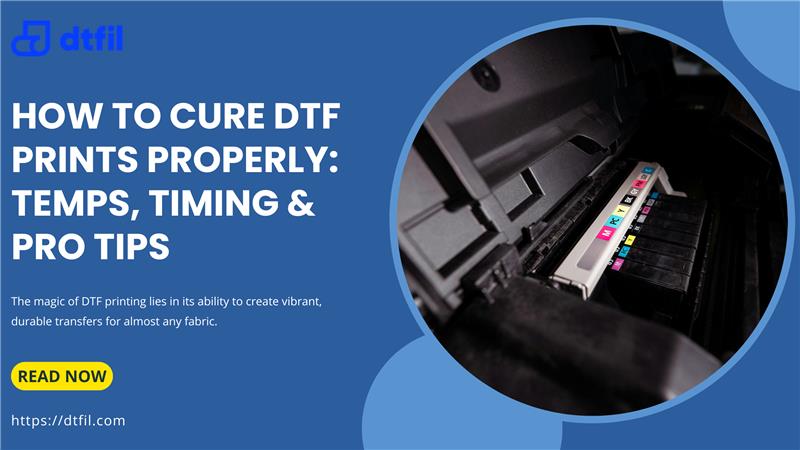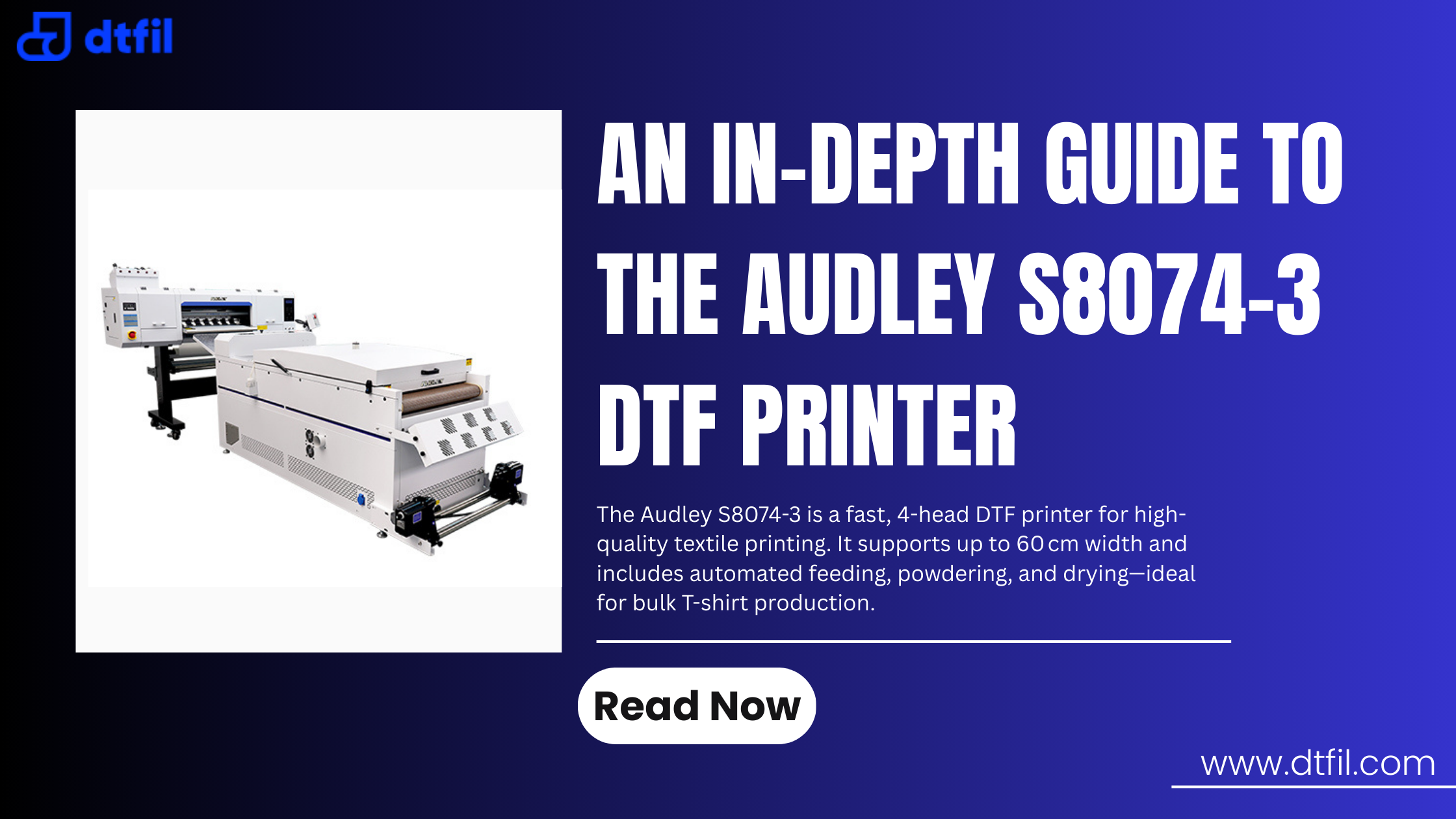Direct to Film (DTF) printing is about to enter a new phase of innovation in the garment industry. Its uniqueness lies not just in the quality and efficiency it offers but also in the challenges it brings, especially when it comes to preserving a safe working environment. In addition to safeguarding the workers, knowing and putting safety procedures in place during DTF operations guarantees a continuous production flow, which eventually helps you succeed. This dedication to safety is more than just compliance; it is an essential factor that drives the operation's overall performance and long-term viability.
This guide provides comprehensive safety guidelines, optimal settings, and troubleshooting tips to ensure you achieve the best results while staying safe.
Understanding DTF Heat Press Settings
1. Optimal DTF Heat Press Settings in Celsius
The key to successful DTF transfers lies in using the correct temperature settings. DTF Temperature Adjust based on material
- 100% Cotton 300-315°F for 10-13 secs
- 100% Polyester 250-275°F for 7-8 secs.
This range helps ensure that the film's adhesive melts properly, allowing it to bond with the fabric. However, the ideal temperature can change based on the kind of fabric and film. For instance, thicker fabrics might require slightly higher temperatures, while delicate fabrics like silk may need lower temperatures to prevent damage.
Always follow the instructions provided by the manufacturer for your particular DTF film to determine the ideal setting. Performing a test print on a scrap piece of fabric is also a good practice to avoid costly mistakes.
Also Read: How to Choose the Best DTF Transfer Film?
2. Pressure and Time Settings
Alongside temperature, pressure and time are critical factors in the DTF heat press process. When the pressure is right, the transfer sticks to the substrate nicely and doesn't break it. The fabric's thickness and kind should be taken into consideration while adjusting the pressure setting. Generally, a medium to firm pressure setting is recommended for most fabrics.
The pressing time typically ranges from 10 to 15 seconds. This duration allows the adhesive to melt and bond properly without scorching the fabric. Again, always refer to the specific recommendations for your materials to avoid over-pressing or under-pressing.
Ensuring Safety While Using a DTF Heat Press
Working with high-temperature equipment like a DTF heat press requires adherence to safety protocols to prevent accidents and injuries.
1. Pre-Use Inspection
Before starting any DTF heat press operation, conduct a thorough inspection of the equipment. Because defective power cords might result in electrical risks, look for any wear or damage on the cord. Ensure that the heating platen and other surfaces are clean and free from any debris that could affect the transfer process or pose a fire risk.
2. Proper Ventilation
The heat transfer process can produce fumes, especially when using certain types of inks or films. Inhaling excessive amounts of these vapors can be dangerous. To lower this danger, always operate in an area with adequate ventilation. If possible, use an exhaust fan or fume extractor to remove any airborne particles and fumes from the workspace.
3. Handling Hot Surfaces
The heating plate and other parts of the heat press can reach extremely high temperatures, posing a burn risk. When handling hot objects or adjusting the machine, always use heat-resistant gloves. Never touch the platen directly with your hands, and allow sufficient time for the equipment to cool down before performing any maintenance.
4. Emergency Procedures
Familiarize yourself with emergency procedures in case of accidents. This includes knowing the location of the nearest fire extinguisher and first aid station. If you are working in a shared or commercial space, ensure that all staff are trained in these procedures.
Also Read: Guide to Print DTF Transfers for the Best Results
Troubleshooting Common DTF Heat Press Issues
Despite following all the recommended guidelines, you may still encounter issues during the DTF heat press process. Here are some common problems and how to address them:
1. Uneven Heating
Uneven heating can result in inconsistent transfers, with some parts of the design not adhering properly. This issue often arises from worn-out heating elements or inadequate maintenance. Regularly check the heating plate for any build-up of residue, which can cause uneven heat distribution. If the problem persists, it may be necessary to replace the heating element or consult with the manufacturer for professional repairs.
2. Adhesion Problems
Adhesion problems, where the transfer does not stick properly to the fabric, can be due to incorrect temperature, pressure, or time settings. Make sure the settings you are using are appropriate for the DTF film and cloth that you have. Furthermore, the fabric's surface needs to be spotless and clear of any impurities that can impede the adhesive, such as dust, oils, or other substances.
3. Color Bleeding
Color bleeding can occur when the ink spreads beyond the intended areas during the heat press process. Either too much heat or pressure can be the cause of this. Use the proper pressure and temperature settings to prevent this. Also, check the moisture content of the fabric, as too much moisture can cause the colors to bleed.
4. Fading or Discoloration
Fading or discoloration of the print can result from using incorrect heat settings or poor-quality materials. Always use high-quality DTF films and inks, and ensure your heat press settings are optimized for the specific materials you are working with. Additionally, using protective sheets can help prevent direct contact between the heating plate and the fabric, reducing the risk of scorching.
The Importance of Proper Pressure in DTF Heat Press Settings
Ensuring the longevity and quality of the DTF transfer requires the right amount of pressure. Insufficient pressure can result in incomplete transfers, where parts of the design do not adhere to the fabric, leading to a patchy appearance. On the other hand, excessive pressure can cause the design to become distorted, with blurred lines or over-saturated colors.
To determine the correct pressure, consider the thickness and type of the fabric as well as the design's intricacy. Delicate fabrics may require lighter pressure, while thicker materials need firmer pressure. Always start with a test print to adjust the pressure settings accordingly before beginning a full production run.
Also Read: Troubleshooting Common Issues During DTF Transfer
Tips for DTF Heat Press Success
1. Regular Maintenance
Maintaining your DTF heat press regularly is essential for longevity and reliable operation. This includes verifying the pressure mechanisms, calibrating the temperature settings, and cleaning the heating plate to get rid of any residue that can interfere with heat dispersion. You'll get greater results and prolong the life of your machine if you maintain your equipment.
2. Proper Storage of Materials
Keep your DTF films, inks, and other supplies out of direct sunlight in a cool, dry location. The quality and shelf life of these materials can be impacted by heat or moisture exposure, which might result in poor prints. Until they are ready to use, always store them in their original packaging.
3. Training and Education
Constant training and education are essential whether you manage a printing company with employees or are a lone proprietor. Keep abreast of the most recent methods, supplies, and safety regulations in the field. This information guarantees a safe working environment in addition to helping you produce work of higher quality.
In conclusion, mastering the heat press settings and following safety procedures are essential for producing DTF transfers of the highest quality. To maintain your equipment operating at its best, always refer to the manufacturer's instructions for the materials you are using. You should also do routine maintenance inspections. Keeping up with industry standards and safety procedures also requires proper training and ongoing education.
Ready to take your DTF heat press settings to the next level? Explore our top-quality DTF heat press machines and films at DTF IL.
FAQs
- What are the optimal DTF heat press settings in Celsius?
The optimal DTF heat press settings typically range between 160°C to 170°C. However, the precise temperature can change based on the kind of film and fabric being utilized. For advice on the ideal temperature settings for your specific materials, always refer to the manufacturer's instructions. It's also advisable to perform a test print to ensure the temperature is correctly set to achieve the best transfer results.
- How can I ensure safety while using a DTF heat press?
Ensuring safety while using a DTF heat press involves several key practices:
- Pre-Use Inspection: Regularly check the equipment for any signs of wear and tear, such as damaged power cords or faulty heating elements.
- Appropriate Ventilation: To prevent breathing in fumes produced during the transfer process, work in a space with adequate ventilation.
- Handling Cautions: Never handle hot items without wearing heat-resistant gloves, and keep your hands away from the heated plate.
- Emergency Preparedness: Be aware of emergency procedures, such as the location of fire extinguishers and first aid kits, and ensure all staff are trained in these protocols.
- What should I do if my DTF heat press doesn't heat up evenly?
Improper maintenance or problems with the heating elements could be the cause of your DTF heat press's uneven heating. To deal with this:
- Verify Residue: Make sure there are no residues on the heating plate since this could lead to an uneven distribution of heat.
- Examine the Heating Components: Inspect the heating elements for any indications of deterioration or wear. Consult the manufacturer if repairs or replacements are required.
- Adjustment: Make sure that the machine is calibrated correctly by the manufacturer's instructions. Regular maintenance checks can help prevent uneven heating issues.
- Why is proper pressure important in DTF heat press settings?
Proper pressure is crucial in DTF heat press settings as it ensures that the transfer adheres correctly to the fabric. Incorrect pressure settings can lead to several issues:
- Insufficient Pressure: This can cause incomplete or uneven transfers, leading to a patchy or subpar finish.
- Excessive Pressure: This may result in the design becoming distorted, with colors bleeding or edges blurring. Properly adjusting the pressure based on the fabric type and thickness helps achieve crisp, clear, and durable transfers. It also minimizes the risk of damaging the fabric or the transferred design.








